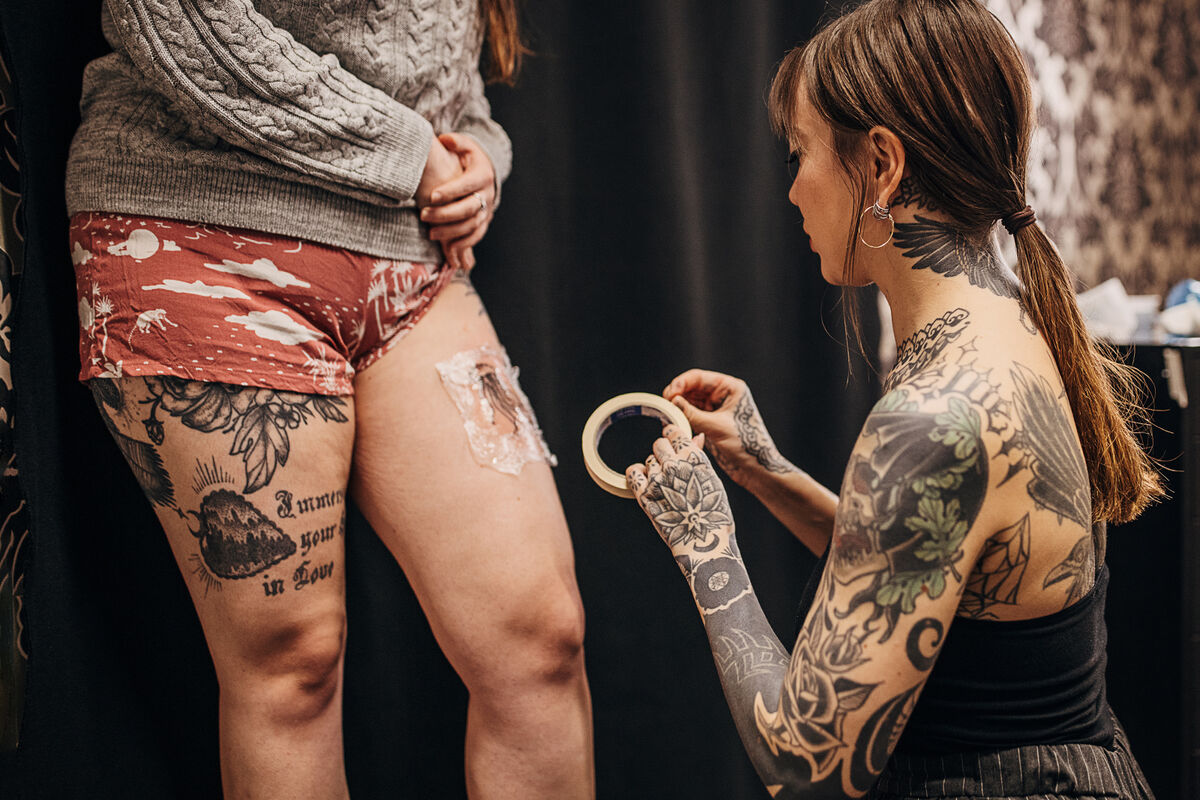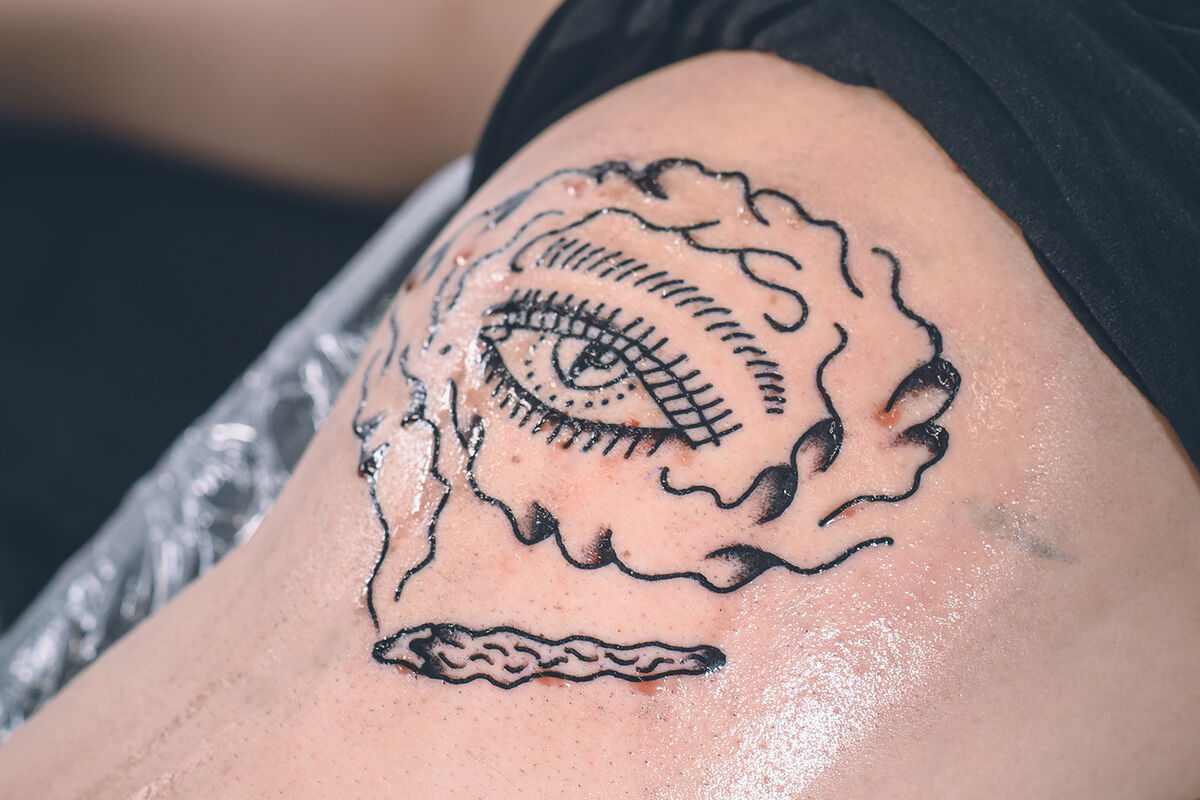Tattoo Aftercare: Instructions, Tips, and Long-Term Maintenance
Keep your new ink looking fresh with basic healing guidelines.

Your new tattoo is awesome - it's vivid, has clean lines, and realistic shading. It's perfect! The artist did a great job. But now it's your turn to make sure your tat heals well and continues to look good. Proper tattoo aftercare can help prevent infection and safeguards your amazing fresh ink.
In most cases, you should leave the ink shop with aftercare instructions. If not, don't worry about it. You'll find out what tattoo aftercare is, why it's so important, and issues to watch out for. And aftercare even extends beyond the basic tattoo healing stages. Find out how to maintain your ink for life.
Tattoo Aftercare 101
Proper tattoo aftercare is about taking ownership of your tattoo and its healing. It is what you do in the hours, days, and weeks following your tattoo session to ensure that new ink heals cleanly and clearly. Proper tattoo aftercare safeguards your health, helps you to avoid infection, and helps to keep every detail and hue of the inked image intact.
Surprisingly, proper aftercare begins before you even get your tattoo. Discuss proper aftercare protocols when you book your appointment so you know what to expect. That allows you to plan the best time to get the tat, and to stock any supplies you may need for care and cleaning. Your tattoo artist will give you a printout of aftercare instructions or provide you with a link to the instructions on their website.
Of course, after the intensity and exhilaration of getting the tattoo, you may feel a bit overwhelmed. That's why having aftercare instructions beforehand is helpful. If the details of what to do slips out of your mind, check your instruction sheet. You can also follow the guidelines here.
Basic Tattoo Aftercare Instructions
General guidelines are included in almost every set of instructions, according to the sample offered by San Mateo County Health. But some areas of aftercare may be slightly different, depending on your personal health level, the placement of the tattoo, and the environment or climate where you live.
Make sure to follow the instructions of a licensed tattoo artist and contact your artist or healthcare provider if anything abnormal arises. If you didn't get aftercare instructions, you can find some simple steps offered through the Mayo Clinic and American Academy of Dermatology (AAD).
General Aftercare Tips
- Wash your hands. This is one of the most important aspects to remember to prevent infection. Always wash your hands before touching the area around your new tat.
- Listen to your artist and follow instructions about taking off the bandage or film. Leave it in place for at least 2 hours. But this varies based on the covering. For example, Sanibalm can be left on the fresh tattoo for up to 24 hours, and a new one applied then left on for 3-5 days.
- After removing the initial bandage, gently wash the area with mild soap and warm water. Pat it dry with a clean towel or absorbent paper towel - don't rub.
- The open wound may leak a little (this is called exudate). Just pat dry. It's normal.
- Apply a light moisturizer with clean fingers. It's best to use perfume-free, dye-free, non-petroleum ointment or lotion.
- Unless using Sanibalm, let the tat breathe. Don't re-bandage it but do keep tight clothing and other irritants away from it and keep it clean.
- Wash and moisturize the tat about three times a day. This depends on your occupation and activity. If you can't avoid some sweat or dirt, you'll have to clean more frequently. Minimize exposure to daily grime.
- Stay out of the sun. UV rays can prompt scabs and scars, according to the Journal of Clinical and Aesthetic Dermatology (JCAD).
- Don't pick or scratch dry, itchy skin. This protects the look and color of the tattoo.
- Avoid swimming or soaking in water. RELATED_1670523200637|How Long Does a Tattoo Take to Heal? The 3 Healing Stages
Reduce the Risk of Complications
In addition to the guidelines above, you'll also want to follow a few tips to make sure you avoid infection and issues, according to Mayo Clinic and San Mateo County Health.
- No sleeping on your tattoo. If you're working on a full back, sleep on your stomach for a few weeks. Switch sides to accommodate a left-side or right-side tattoo and keep pressure off it as you slumber. Your tat, and your sheets, will thank you.
- Skip the gym. Sweat and straining aren't great for your new tattoo. So, you might need to avoid the gym for a week or so.
- Do not wear tight clothing. The friction of a tight belt, waistband, bra strap, or Lycra gear will irritate the scab and remove the ink. Tight or closed shoes will rub the scab off and could lead to infection. Go for the baggy look at the office or out in public.
Look for Signs of Infection
Infection is the most common complication to interfere with tattoo healing, according to the Journal of Cutaneous and Aesthetic Surgery. Persistent redness, tenderness, swelling, a bumpy rash, excessive drainage, or oozing pus are all signs to see your healthcare provider. So is evidence of an allergic reaction to pigments and dyes.
Allergies might resemble an infection or show up as an annoying, persistent itchy rash at the site. Medication provides some relief from an allergic reaction and ends an infection before it has a chance to take hold. Be diligent about any signs of a problem while you are following the aftercare protocol, and see a healthcare professional for any complications.
Typical Timeline of Tattoo Healing
The critical part of aftercare is the first two weeks after you get your new tattoo, according to Mayo Clinic. The stages break down - roughly - into three stages.
Days 1-4

You will generally be advised to remove the bandage after 2-3 hours. (Wash your hands first!) Wash the tattoo, pat it dry, and moisturize. Repeat 2-3 times before bed (depending on when you get the tattoo). Wash, dry, and moisturize 3-4 times a day, leaving the tattoo exposed to the air.
Days 3-5
The tattoo will scab over and start to itch. Don't scratch it. Continue to follow cleaning and moisturizing instructions while the wound is healing. Once the scab forms, you can switch from an ointment to a lighter, non-scented lotion moisturizer such as over-the-counter Aveeno, Lubriderm, or Curel.
Day 5-Beyond
Keep washing, keep moisturizing, and continue to keep your hands off of the itchy flaking scab. You'll be able to watch your tattoo slowly emerge as the scab falls off. Avoid baths, swimming, or hot tubs. Your tattoo needs air-drying and moisturizer.
Your newly healed tattoo is still tender. The skin may be slightly pink and shiny once the scab falls off. Stay out of the sun, drop the frequent washing, but continue regular, gentle cleaning and moisturizing because tattoos need about 4 weeks to heal completely. Once your tattoo is healed, make sure to use sunscreen to protect your ink from UV rays.
Long-Term Tattoo Maintenance
Exposure to the sun fades all tattoos, so use sunblock and wear cover-up clothing to protect your shiny new tattoo from damage. The colors and detail will remain distinct longer when you control for sun exposure. Use SPF 30 sunscreen - a higher SPF is better - and frequently reapply when you are sweaty or after swimming, according to JCAD.
Regular moisturizing is another new habit to develop. Dry skin sheds cells more quickly, and those cells contain microscopic bits of tattoo pigment. Moisturize often to avoid premature aging of the tattoo. Consider the artwork on your skin as an investment and commit to preserving the fine lines and fab color of your brand-new tattoo with regular maintenance.